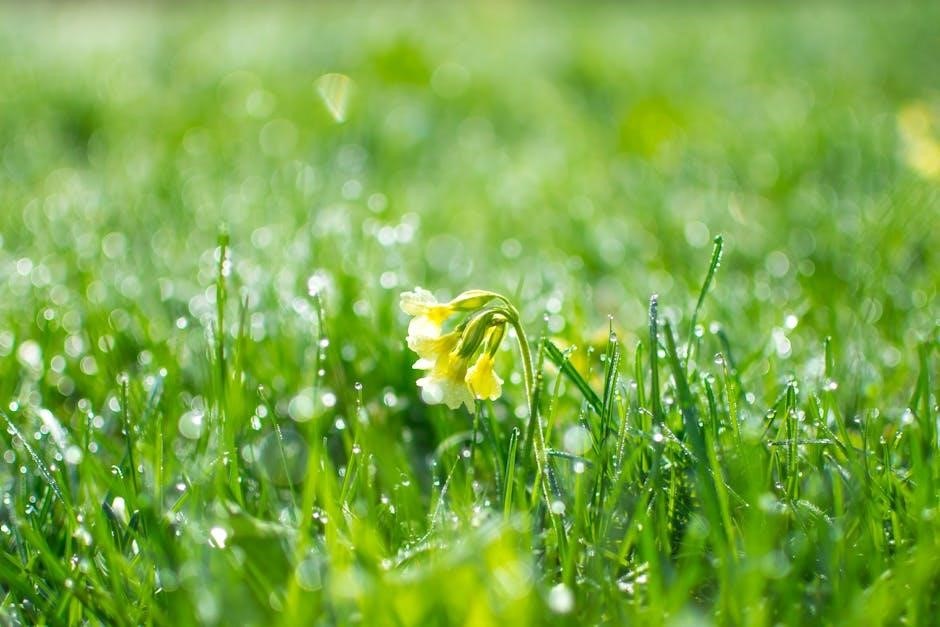
The housefly undergoes a complete metamorphosis, transitioning through four distinct stages: egg, larva (maggot), pupa, and adult. Understanding this lifecycle is crucial for effective pest management strategies. Each stage presents unique vulnerabilities that can be targeted to control housefly populations.

Complete Metamorphosis
Houseflies exhibit complete metamorphosis, a biological process involving four distinct life stages. This transformation includes the egg, larva (maggot), pupa, and adult phases. Each stage differs significantly in morphology and ecological role, driving housefly development and reproduction.
Egg Stage
The housefly life cycle commences with the egg stage. These eggs are small, elongated, and typically yellowish-white in color, measuring approximately 1 mm in length. Female houseflies deposit these eggs in clusters, often numbering around 100, within suitable food sources that will nourish the developing larvae. These sources include manure, decaying organic matter, spilled feed, and other moist, warm environments conducive to larval development.
The female can lay multiple batches, potentially depositing between 350 to 900 eggs throughout her lifespan. Egg deposition usually occurs in cracks and crevices near the food source. Under favorable conditions, such as warm temperatures, the eggs hatch rapidly, typically within 8 to 24 hours. This quick hatching period is crucial for the housefly’s rapid reproduction rate and subsequent population growth. The newly hatched larvae then begin their feeding and growth phase.
Larval Stage (Maggot)
Following the egg stage, the housefly enters its larval stage, commonly known as the maggot stage. These larvae are yellowish-white, legless, and possess a cone-shaped body, adapted for burrowing and feeding within their chosen substrate. The primary focus of the maggot is to consume organic matter and accumulate energy for the subsequent pupal transformation. They thrive in decaying organic materials such as manure, spilled feed, and garbage.
The larvae undergo significant growth during this stage, molting their exoskeletons several times. As they feed voraciously, they increase in size and store essential nutrients; This larval development is critical for the fly’s overall survival and reproductive success. The duration of the larval stage is influenced by environmental factors, most notably temperature and the availability of nutritious food.
Three Larval Instars
Within the maggot stage, housefly larvae progress through three distinct phases known as instars. Each instar represents a period of growth and development between molting. The first instar larva emerges from the egg and begins feeding immediately. As it grows, it sheds its exoskeleton, marking the transition to the second instar.
The second instar larva continues to feed and increase in size, preparing for another molt. Finally, the larva molts again, entering the third instar, the final larval stage. During this phase, the larva accumulates maximum reserves of energy and resources. These reserves will be crucial for the non-feeding pupal stage, where significant transformation into the adult fly occurs. The duration of each instar depends on environmental conditions such as temperature and food availability.
Feeding and Growth of Larvae
The larval stage of the housefly is characterized by intense feeding and rapid growth. Maggots primarily feed on decaying organic matter, such as manure, spilled feed, and garbage. This feeding is essential for accumulating the necessary energy and nutrients to support later development during the pupal stage. The larvae possess specialized mouthparts adapted for consuming semi-liquid substances.
The rate of larval growth is highly dependent on environmental factors, particularly temperature and the availability of suitable food sources. Warmer temperatures accelerate metabolic processes, leading to faster feeding and growth rates. Conversely, colder temperatures slow down development. A plentiful supply of nutrient-rich food promotes optimal growth. If food is scarce or of poor quality, larval development will be prolonged, potentially impacting the survival and reproductive success of adult flies.
Pupal Stage
The pupal stage represents a transformative phase in the housefly’s lifecycle. After the final larval instar, the larva ceases feeding and seeks a dry, sheltered location. Here, it transitions into a pupa, undergoing significant physiological and morphological changes. This stage is a bridge between the larva and the adult fly, a period of intense internal reorganization. The pupa is enclosed within a hardened, protective shell called the puparium.

The puparium, initially the skin of the last larval instar, darkens and hardens to provide protection from environmental stressors and predators. Within the puparium, the larval tissues are broken down, and new adult structures are formed. This process, known as histolysis and histogenesis, requires considerable energy and resources. The duration of the pupal stage varies depending on factors like temperature, but it is a critical phase for the successful development of the adult fly.
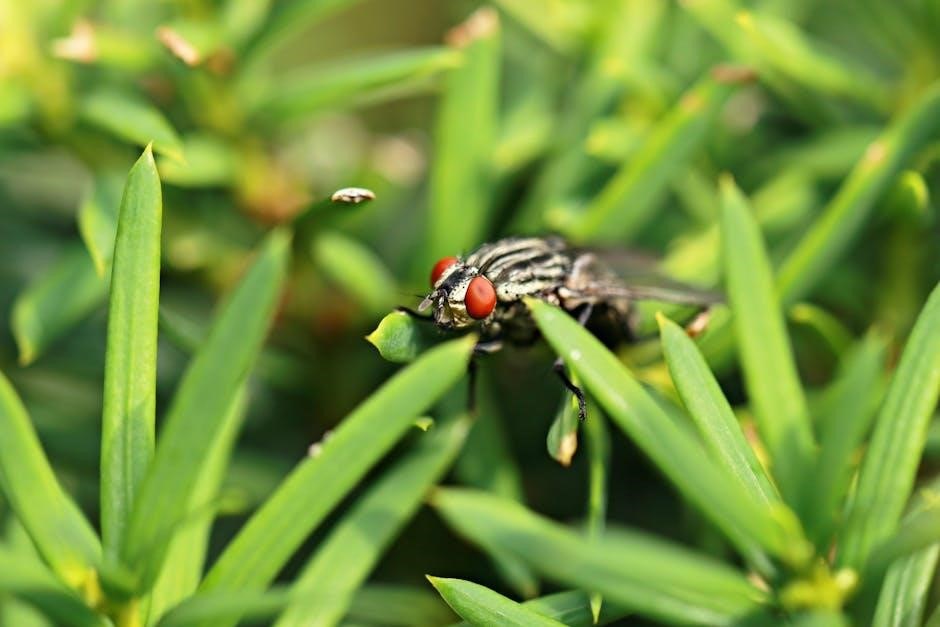
Formation of the Puparium
The formation of the puparium marks the beginning of the pupal stage and is a critical step in the housefly’s metamorphosis. As the fully-grown larva prepares to pupate, it ceases feeding and seeks a suitable, often drier, location. The larva’s skin then begins to harden and contract, gradually forming a barrel-shaped, protective shell known as the puparium. This process involves the tanning and hardening of the larval cuticle, transforming it into a rigid, dark-colored casing.
The puparium serves as a protective barrier, shielding the developing pupa from physical damage, desiccation, and predation. Initially, the puparium is a light yellowish-brown color, but it darkens over time as the cuticle hardens further. This hardened shell provides a stable environment within which the dramatic transformation from larva to adult fly can occur, ensuring the survival of the organism during this vulnerable stage of development. The puparium’s formation is essential for the housefly’s successful completion of its life cycle.
Transformation within the Pupa
Within the confines of the hardened puparium, a remarkable transformation takes place as the larval tissues undergo complete reorganization into the adult form. This process, known as metamorphosis, involves the breakdown of larval structures and the development of adult-specific tissues and organs. Specialized cells, called histoblasts, initiate the formation of the adult fly’s head, thorax, abdomen, wings, legs, and other essential features.
This complex process is carefully orchestrated by hormones and genetic factors, ensuring the proper development of each anatomical structure. The pupa remains relatively immobile during this period, relying on the resources stored within its body to fuel the energy-intensive transformation. The duration of this stage varies depending on environmental conditions such as temperature, but it is a crucial phase in the housefly’s life cycle, ultimately leading to the emergence of the fully formed adult fly.
Adult Stage
The adult stage represents the final phase in the housefly’s life cycle, characterized by reproductive maturity and the ability to disperse and colonize new environments. Adult houseflies typically emerge from the puparium within a few days to several weeks, depending on environmental factors such as temperature and humidity. Newly emerged adults are initially soft-bodied and require time for their exoskeletons to harden and their wings to fully expand;
Adult houseflies are highly mobile and capable of sustained flight, allowing them to search for food sources, mates, and suitable oviposition sites. They feed on a wide range of organic materials, including decaying matter, sugary substances, and liquid waste. The primary focus of adult houseflies is reproduction, with females typically laying multiple batches of eggs throughout their lifespan. The adult stage is therefore vital for the continuation and propagation of housefly populations.
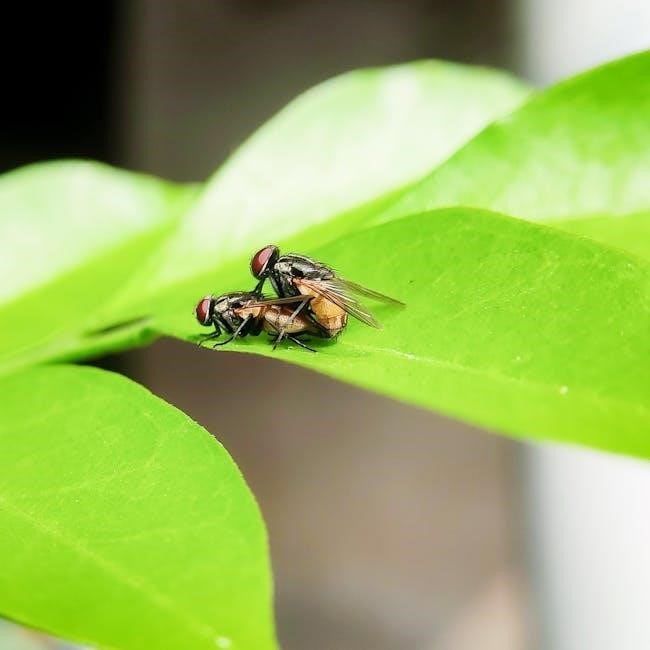
Emergence of Adult Flies
The emergence of adult flies from the puparium marks a significant transition in their life cycle, signaling the completion of metamorphosis. This process typically occurs when environmental conditions are favorable, such as when temperatures are warm and humidity levels are adequate. During emergence, the adult fly uses a specialized structure on its head, called the ptilinum, to rupture the puparium.
The newly emerged adult is initially weak and vulnerable, with its wings folded and its exoskeleton soft. It requires time to expand its wings, allowing them to dry and harden. Once the wings are fully developed, the adult fly is capable of flight and can begin searching for food and mates. Emergence is a critical stage, influencing the fly’s subsequent survival and reproductive success. The timing of emergence is influenced by environmental factors.
Mating and Reproduction
Within 24 hours of emerging, adult house flies are capable of mating. Successful reproduction is crucial for sustaining housefly populations, and it is directly influenced by environmental conditions and resource availability. After mating, the female housefly begins to develop eggs within her ovaries. The female fly requires a protein-rich meal to facilitate egg development, often seeking out sources such as manure, spilled feed, or decaying organic matter to obtain the necessary nutrients.
The female housefly is capable of laying multiple batches of eggs throughout her lifespan. Each batch can contain from 75 to 200 eggs, and a single female can lay up to 900 eggs in her lifetime. The eggs are typically deposited in clusters within suitable food sources, ensuring that the newly hatched larvae have immediate access to sustenance. The reproductive capacity of houseflies contributes to their rapid population growth and persistence in various environments.
Egg Laying Capacity
Female house flies exhibit a remarkable egg laying capacity, contributing significantly to their rapid population growth. A single female can lay multiple batches of eggs during her lifespan, with each batch containing approximately 75 to 200 eggs. Over her lifetime, a female house fly can deposit between 350 and 900 eggs, distributed across several batches. The precise number of eggs laid depends on factors such as temperature, food availability, and overall environmental conditions.
Females typically lay their eggs in clusters within suitable breeding sites, such as manure, decaying organic matter, or spilled feed. These locations provide the newly hatched larvae with a readily available food source, ensuring their survival and development. The ability to lay numerous eggs, coupled with rapid development under favorable conditions, enables house fly populations to proliferate quickly, posing challenges for effective pest management.

Factors Affecting Life Cycle Duration
The duration of the housefly life cycle is significantly influenced by environmental conditions, particularly temperature and the availability of suitable food sources. These factors play a crucial role in the rate of development at each stage.
Temperature Influence
Temperature is a primary driver of housefly development, influencing the speed at which each life stage progresses. Warmer temperatures generally accelerate the housefly life cycle, reducing the time required for eggs to hatch, larvae to mature, and pupae to transform into adults. Conversely, cooler temperatures slow down these processes, extending the duration of each stage.
Optimal temperatures for housefly development typically range between 70°F and 90°F (21°C and 32°C). Within this range, the entire life cycle can be completed in as little as seven to ten days. However, extreme temperatures, both high and low, can be detrimental, inhibiting development or even causing mortality. This temperature dependence has significant implications for housefly populations in different climates and seasons. Understanding the relationship between temperature and housefly development is essential for predicting population dynamics and implementing effective control measures.
Availability of Food Sources
The availability and quality of food sources play a crucial role in the housefly life cycle, particularly during the larval stage. Maggots require nutrient-rich substrates to fuel their rapid growth and development. Decaying organic matter, such as manure, spilled feed, and garbage, serves as ideal breeding and feeding grounds for housefly larvae.
The abundance of these food sources directly impacts larval survival rates and the size and vigor of emerging adult flies. Limited food availability can lead to slower larval development, increased mortality, and smaller adults with reduced reproductive capacity. Conversely, ample food resources promote rapid larval growth, higher survival rates, and larger, more robust adults. Controlling access to suitable breeding substrates is, therefore, a cornerstone of effective housefly management strategies. Proper waste disposal, sanitation practices, and minimizing spilled feed can significantly reduce housefly populations by limiting larval food sources.
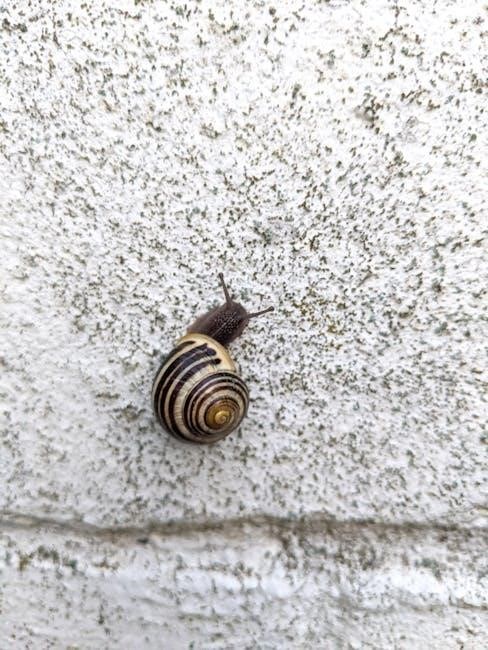
Housefly Lifespan
The adult housefly lifespan typically ranges from 15 to 30 days, but this duration is significantly influenced by environmental factors. Temperature and food availability are key determinants of how long an adult housefly will live.
Average Adult Lifespan
The average lifespan of an adult housefly typically falls between 15 to 25 days, although some may survive for up to a month under optimal conditions. Several factors influence this lifespan, including temperature, humidity, and access to food and water. In warmer environments, the metabolic rate of houseflies increases, leading to a shorter lifespan. Conversely, cooler temperatures can extend their survival.
Adequate nutrition and hydration are also vital for prolonging adult housefly lifespan. Flies that have consistent access to sugary substances and protein sources tend to live longer than those with limited resources. The presence of predators and the availability of suitable resting places can also affect lifespan.
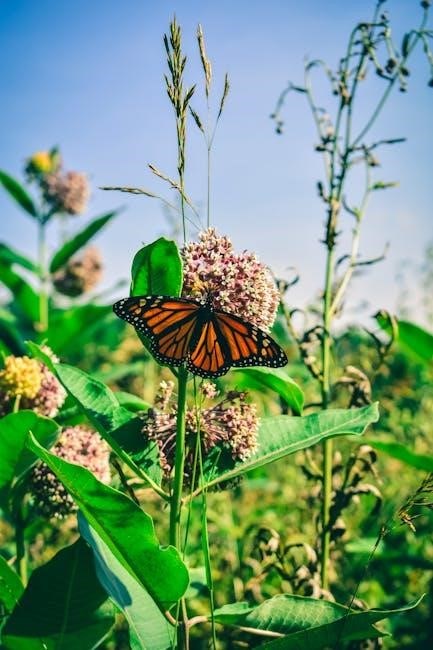
Breeding Habitats
Houseflies thrive in environments with decaying organic matter. Common breeding sites include manure, spilled feed, garbage, and other moist, warm materials. These locations provide the necessary nutrients for larval development and survival.
Manure and Decaying Organic Matter
Manure, particularly from livestock, is a prime breeding ground for houseflies. The moist and nutrient-rich composition provides an ideal food source for developing larvae. Similarly, decaying organic matter, such as rotting fruits, vegetables, and food waste, also supports housefly reproduction. These materials offer a suitable environment for egg-laying and subsequent larval growth. The decomposition process releases essential nutrients that fuel the maggots’ development.
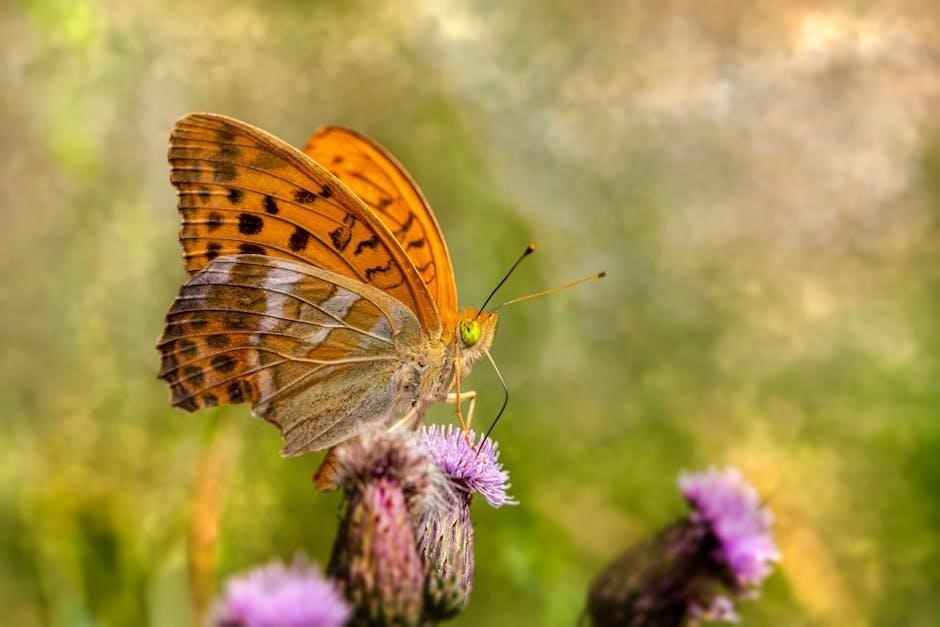
Proper management of manure and organic waste is crucial in controlling housefly populations. Regular removal, composting, or other treatment methods can significantly reduce the availability of breeding sites. Effective sanitation practices in agricultural and residential settings are essential for minimizing housefly infestations. By limiting access to these breeding habitats, the housefly lifecycle can be disrupted, leading to a decrease in their numbers.

Types of House Flies
While the common housefly is prevalent, other species exist, including the lesser housefly. These differ slightly in behavior and habitat preference. Recognizing these variations is helpful for targeted control strategies.
Common House Fly
The common house fly (Musca domestica) is a ubiquitous insect found in close association with humans. Its lifecycle, typical of muscoid flies, involves complete metamorphosis: egg, larva (maggot), pupa, and adult. Females deposit eggs in clusters on decaying organic matter. These eggs hatch quickly into larvae, which feed voraciously and grow rapidly through three instars.
Pupation occurs within a hardened puparium, where transformation into the adult fly takes place. Adults emerge, mate, and females can lay hundreds of eggs in their lifetime. This rapid lifecycle allows for quick population growth under favorable conditions. Understanding this cycle is key to control.
Lesser House Fly
The lesser house fly (Fannia canicularis) exhibits a lifecycle similar to the common house fly, with complete metamorphosis. However, it displays distinct behavioral and ecological differences. The lifecycle stages include egg, larva, pupa, and adult. Lesser house fly larvae are often found in cooler, more liquid media than common house fly larvae.
Adults are known for their erratic, hovering flight patterns within structures. The development time is temperature-dependent. Females lay eggs in decaying organic matter. Understanding the subtle differences in habitat preference and behavior is crucial for implementing targeted control measures, distinguishing it from the common house fly.